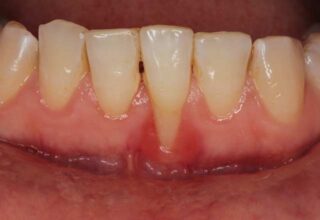
More Dental Health Articles
Understanding Muco-Gingival Defects and Gingival Recession

Definitions, Treatment Timing, and Options
Maintaining optimal oral health goes beyond just brushing and flossing; it also involves addressing various dental conditions to ensure a healthy smile. Two common issues that affect gum health are muco-gingival defects and gingival recession. Let’s delve into their definitions, when to seek treatment, and the available treatment options.
Muco-Gingival Defects
Muco-gingival defects refer to a range of conditions that involve both the gingiva (gums) and the mucosa (soft tissue lining of the mouth). These defects can manifest as irregularities, discrepancies, or abnormalities in the interface between the gums and the surrounding oral tissues. They might result in gum recession, soft tissue loss, or pockets forming between the gum and the teeth. Muco-gingival defects can lead to increased sensitivity, difficulty in maintaining oral hygiene, and potential aesthetic concerns.
Gingival Recession
Gingival recession is a specific form of muco-gingival defect where the gum tissue gradually recedes, exposing the tooth’s root. This can be caused by factors such as aggressive brushing, poor oral hygiene, gum disease, genetic predisposition, and even orthodontic treatment. Gingival recession can lead to tooth sensitivity, increased risk of decay on exposed roots, and aesthetic concerns due to the appearance of longer teeth.
When to Seek Treatment
Early detection and intervention are crucial for managing both muco-gingival defects and gingival recession. If you notice symptoms like tooth sensitivity, longer-looking teeth, or changes in gum appearance, consult a dentist. Regular dental check-ups can help identify these issues in their early stages, allowing for timely treatment.
Treatment Options:
- Oral Hygiene Improvement: In mild cases, better oral hygiene practices and using a soft-bristle toothbrush can help prevent further recession. Dentists might also recommend changes in brushing techniques to avoid damaging the gums.
- Gum Grafting: For moderate to severe cases, gum grafting is a common surgical procedure. Tissue from the patient’s palate or a donor source is placed over the exposed root, restoring gum coverage and reducing sensitivity. At times, no coverage of the root is predictable, so merely increasing the quality and quantity of the existing gum is attempted.
- Orthodontic Intervention: In some cases, gingival recession might result from improper tooth positioning. Orthodontic treatment can help reposition teeth to reduce recession risk.
- Maintaining Healthy Habits: After treatment, maintaining good oral hygiene practices and regular dental visits are vital to prevent recurrence.
Other Articles You May Find of Interest...
- Fun and Effective Ways to Teach Kids About Cavities and Oral Hygiene
- ALF (Advanced Light Force) Therapy: A Unique and Sophisticated Approach To Orthodontics and Wellness
- Tongue-Ties and Frenectomies
- Unlocking Better Sleep:The Benefits of Dental Sleep Appliances Over CPAP
- Appliances Are In Now: How To Manage TMJ Disorder
- Why The Tooth Fairy Is Very Fun – and Important!
- Let’s Smile Dental’s 7&Up Club

















